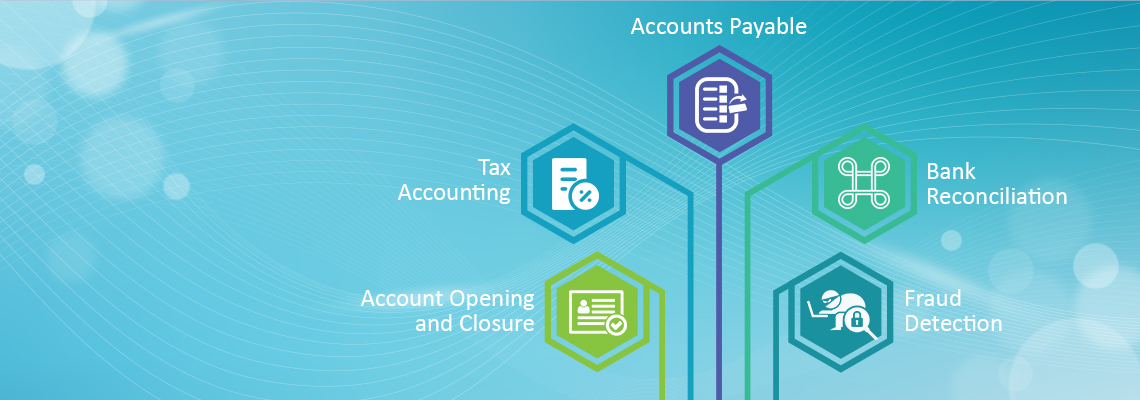Major financial institutions are still treading water when it comes to Robotic Process Automation. They are starting small with tightly articulated pilot programs with clear objectives. Often, the primary roadblock in implementation of RPA programs start with qualification of right processes to automate. In this blogpost we explore five areas that you can easily automate using RPA platforms.

1. Accounts Payable
There has been a considerable amount of skepticism considering the inconsistencies and lack of structure in invoices, that RPA would be able to make significant impact in this space. This derives from the reliance of major RPA tools on OCR (Optical Character Recognition) technology which were quiet inefficient in the early part of the last decade. But OCR tools have gained a lot of maturity, not to mention features like automated exception/approval would allow enterprises to consider process automation. The benefits outweigh the skepticism. Automation can reduce error rates by a significant margin which would save time and cost. It streamlines systematic invoice generation ensuring end to end payment processing. Also, the ability to easily replicate RPA across other financial process and business segments makes it easier to scale along with the growth of the business
2. Tax Accounting
Global financial institutions spend millions of dollars every year in offshoring their Tax Accounting activities. These activities are very manual, repetitive starting from acquiring necessary information regarding trial balance, fixed assets, other company specific data to reviewing tax returns and calculating deferred taxes. Not to mention the information are often work in conjunction with ERP platforms, financial management and payroll processing software. By leveraging RPA enterprise can easily achieve rapid results in terms of tax automation while saving huge costs on offshore accounting. Not to mention the existing RPA tools are non-invasive that enables little to no customization of the enterprise technology ecosystem. RPA for Tax Accounting is quiet a no brainer and would be the most popular use case for automation.
3. Bank Reconciliation
Enterprises spend arduous energy every year in manually reviewing and validating inline transactions. While the advent of various fragmented solutions have reduced the painstaking process of going through journal entries, they still are swimming upstream towards challenges like transaction volumes, muddled processes and unending sources of data feeds. Reconciliation was one of the early use cases identified by experts as an apt candidate for automation. It would allow enterprises to make some quick cost reductions while improving the workload of back office staff allowing them to engage in activities that are more fulfilling. Leveraging RPA solutions enterprises can build applications for reconciliations that would offer sophisticated data comparison, automated journal entries, and long term archiving.
4. Account Opening and Closure
Bank Relationship Managers have a demanding job in today’s fast and dynamic environment. They often have hundreds of accounts assigned to them at various phases in their relationship. This sets them up against the impossible challenge of handling these multiple accounts simultaneously while delivering superior customer experience to each and every one of them. It’s basically setting them up for failure.
Automation has come as an instantaneous relief for relationship managers. Recently, India based Axis bank transformed about 85% of household and savings account opening through tablets – of which 50% done through eKYC. This coupled with Robotic Process Automation can streamline customer onboarding for relationship managers where they can as they can easily monitor credit ratings and score, analyze default risks, and also complete eKYC processes through automation.
Similarly, when it comes to account closure bots can act on the service request generated by the branch and update the banking system, generate transaction id, input MIS with respective status. The accuracy of RPA systems would enable in reducing the errors when it comes to deferred recovery charges or closure rate.
5. Fraud Detection
No single issue in Financial Industry hurts enterprises more than fraud and identity theft. According to a report by Javelin Strategy & Research, 15.4 million consumers where victims to some form of fraud in 2016 estimating a total loss of up to $16 billion.
Currently, many organizations have built home grown systems to proactively tackle fraud detection. Leveraging RPA techniques banks can be more monitoring and eliminating threats before they become massive to handle. Automated alerts and notifications can generated to important parties involved and can also be used to trigger chain of events ensure a recovery. Coupled with machine learning and predictive analytics platforms can analyze existing data and previous threats to create defense mechanism that can identify and distinguish real from fraudulent transactions.
In 2017, PWC’s RPA survey found that 30% of their respondents were on their way to enterprise adoption. Also their Digital IQ survey concluded that about half (52%) of the financial services industry were making ‘substantial investments’ in AI led by robotic and cognitive process automation. KPMG estimated that robotic process automation could help financial services cut costs by up to 75%
In the last couple of years, we have worked with leading Financial Institutions to help them automate various business processes to save time and costs. We have worked with these organizations help them identify problem areas and adopt RPA within their enterprise ecosystems. Learn more about our RPA capabilities here.

